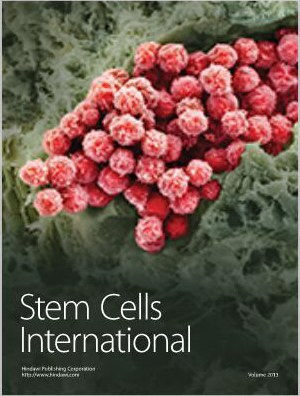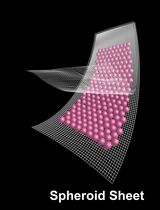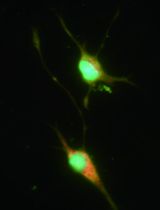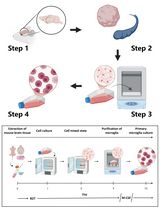- EN - English
- CN - 中文
Isolation and Establishment of Mesenchymal Stem Cells from Wharton’s Jelly of Human Umbilical Cord
从人脐带华通氏胶中分离及建立间充质干细胞
发布: 2018年02月20日第8卷第4期 DOI: 10.21769/BioProtoc.2735 浏览次数: 19117
评审: Vasiliki KoliarakiAnonymous reviewer(s)
Abstract
Mesenchymal stem cells (MSCs) are currently considered as ‘medicinal signaling cells’ and a promising resource in regard to cell-based regenerative therapy. Umbilical cord is a human term perinatal tissue which is easily attainable, and a promising source of stem cells with no associated ethical concerns. MSCs have been isolated from different regions of the umbilical cord and Wharton’s jelly (WJ) is the gelatinous matrix that surrounds and provides protection to the umbilical cord blood vessels. Being more primitive, MSCs from human umbilical cord exhibit greater proliferative capacity and immunosuppressive ability as compared to adult stem cells which gives them a therapeutic advantage. To meet the requirements for cell therapy, it is important to generate MSCs at a clinical scale by following steps which are not time consuming or labor intensive. Here we present a simple, efficient protocol for isolation of MSCs from WJ of human umbilical cord by explant culture method which is reproducible and also, cost effective.
Keywords: Umbilical cord (脐带)Background
Mesenchymal stem cells (MSCs) have a remarkable clinical potential to treat a wide range of debilitating diseases, mainly due to their unique immunomodulatory role and regenerative capacity (Caplan and Sorrell, 2015). They exist in many tissues (Hass et al., 2011) and have been observed to be perivascular in vivo (Caplan and Correa, 2011). The niche of the source or the source itself, could lead to important functional differences between the various MSC types (Kwon et al., 2016). Though bone marrow is the most well studied and best characterized source of MSCs, there are certain limitations associated with it (Liu et al., 2016). An appealing and convenient alternative choice of MSC source is the fetus-derived umbilical cord, which is discarded after birth and provides an easily accessible and non-controversial source of stem cells for therapy (El Omar et al., 2014). Umbilical cord MSC-based trials are still at early phase, though no cell rejection, tumor formation or long-term adverse effects have been reported from them (Zhang et al., 2017). Moreover, they have been successfully used in experimental animal disease models. For convincingly establishing safety and therapeutic efficacy of umbilical cord-MSCs, followed by their use in clinical applications, a vast number of MSCs need to be generated for transplantations (Bartmann et al., 2007).
MSCs have been isolated from different compartments of the umbilical cord and Wharton’s jelly (WJ), is the connective tissue surrounding the umbilical cord vessels (Troyer and Weiss, 2008). Being a primitive stromal cell population, WJ-MSCs offer the advantage of faster proliferation rate and reduced immunogenicity as compared to adult tissue derived MSCs (Liu et al., 2016). Hence, successful isolation of robustly proliferating healthy MSCs from WJ of human umbilical cord, which retain all the basic MSC properties, assumes importance. Here we describe step-by-step an explant method of isolation procedure followed by establishment of MSC culture from WJ of human umbilical cord. This method of isolation eliminates the use of any enzymatic treatment making it more economical, and getting rid of batch-to-batch variations and endotoxin contaminations likely to be associated with enzymatic preparations. The isolated WJ-MSCs expressed MSC-characteristic surface antigens and were positive for the expression of CD73, CD90 and CD105 and negative for CD34.
Materials and Reagents
- 15 and 50 ml centrifuge tubes (Corning, catalog numbers: 430791 and 430829 respectively)
- 1.5 ml microcentrifuge tube (Corning, Axygen®, catalog number: MCT-150-C )
- 90 mm Petri dish sterile (Tarsons, catalog number: 460090 )
- 35 mm cell culture dish (Corning, Falcon®, catalog number: 353001 )
- 1 ml blunt-end pipette tips
- Corning® 1.2 ml External Threaded Polypropylene Cryogenic Vial, Self-Standing with Conical Bottom (Corning, catalog number: 430658 )
- FACS tubes (Corning, Falcon®, catalog number: 352054 )
- Millex-GP Syringe Filter Unit, 0.22 µm, polyether sulfone, 33 mm, gamma sterilized (Merck, catalog number: SLGP033RS )
- 20 ml and 5 ml syringes*
- Sterile Scalpel blade No. 20 (HiMedia Laboratories, catalog number: LA771 )
- 0.5-10 µl microtips (Corning, Axygen®, catalog number: T-300 )
- 20-200 µl pipette tips (Corning, Axygen®, catalog number: T-200-C )
- 100-1000 µl pipette tips (Corning, Axygen®, catalog number: T-1000-C )
- Biohazards disposable waste bags*
- Plastic beaker*
- 0.9% w/v saline*
- Antibiotic-Antimycotic (100x) (Thermo Fisher Scientific, GibcoTM, catalog number: 15240096 )
- Isopropanol*
- Autoclaved distilled water
- Absolute ethanol (Merck, catalog number: 1.00983.0511 )
- Sodium hypochlorite solution (Merck, catalog number: 1.93607.1021 )
- Dulbecco’s phosphate-buffered saline (DPBS), No calcium, no magnesium (Thermo Fisher Scientific, GibcoTM, catalog number: 14190144 )
- TrypLETM Express Enzyme (1x), no phenol red (Thermo Fisher Scientific, GibcoTM, catalog number: 12604013 )
- Trypan blue solution 0.4% (Sigma-Aldrich, catalog number: T8154 )
- Flow cytometry antibodies (Table 1)
Table 1. Flow cytometry antibodiesS. No. Antigen (CD marker) Antibody Manufacturer Dilution 1. CD73 Anti-Human CD73 PE BD, BD PharmingenTM,
catalog number: 5502571.5 µl in 50 µl of cell suspension 2. CD90 Anti-Human CD90 PE BD, BD PharmingenTM,
catalog number: 5555961.5 µl in 50 µl of cell suspension 3. CD105 Anti-Human CD105-PE R&D Systems,
catalog number: FAB10971P1 µl in 50 µl of cell suspension 4. CD34 Anti-Human CD34 BD, BD PharmingenTM,
catalog number: 5507611 µl in 50 µl of cell suspension S. No. Isotype antibody Manufacturer Dilution 1. IgG1, kappa BD, BD PharmingenTM,
catalog number: 5506171µl of 1:16 dilution in 50 µl of cell suspension (for CD73 and CD34) 1.5 µl in 50 µl cell suspension for CD90 2. IgG1 R&D Systems,
catalog number: IC002P1µl of 1:16 dilution in 50 µl cell suspension - KnockOutTM D-MEM high glucose no glutamine (Thermo Fisher Scientific, GibcoTM, catalog number: 10829018 )
Note: DMEM-F12 or DMEM, high glucose could also be used in place of KnockOutTM D-MEM (Nekanti et al., 2010). - L-Glutamine (200 mM) (Thermo Fisher Scientific, GibcoTM, catalog number: 25030149 )
- Fetal bovine serum (FBS) mesenchymal stem cell qualified (Thermo Fisher Scientific, GibcoTM, catalog number: 12662029 )
Note: The source, grade and lot number of FBS play a critical role in MSC culture establishment. - Penicillin-Streptomycin (10,000 U/ml) (Thermo Fisher Scientific, GibcoTM, catalog number: 15140148 )
- Phosphate buffered saline tablets (Sigma-Aldrich, catalog number: P4417 )
- Dimethyl sulfoxide (DMSO) (Sigma-Aldrich, catalog numbers: D2650 )
- Sheath fluid ( BD Biosciences, BD FACS FlowTM, catalog number: 342003 )
- MSC isolation media (see Recipes)
- MSC growth media (see Recipes)
- 1x sterile phosphate buffer saline, pH 7.4 (see Recipes)
- MSC freezing mixture (see Recipes)
*Note: This item can be ordered from any standard company.
Equipment
- Laminar flow hood* (EuroClone, model: S@feflowTM 0.9 , catalog number: LD80000)
- Surgical tools including scalpel holder, forceps (large and small), pointed scissors
- Incubator (BINDER, model: C 150 CO2 Incubator, catalog number: 9040-0078 )
- Centrifuge 5810 R (Eppendorf, model: 5810 R , catalog number: 5811000320)
- Haemocytometer depth 0.1 mm* (Rohem Instruments Private limited, http://www.sciencecorner.co.in/Rohem.php)
- Mr. FrostyTM Freezing Container (Thermo Fisher Scientific, Thermo ScientificTM, catalog number: 5100-0001 )
- -20 °C freezer* (Celfrost, model: BSF 150 )
- -86 °C Upright Ultra-Low Temperature Freezer (Revco value, Thermo Fisher Scientific, Thermo ScientificTM, model: ULT-1386-3 )
- Liquid nitrogen tank (Thermo Fisher Scientific, Thermo ScientificTM, model: Model 8031 )
- Flow cytometer (BD Biosciences, BD FACSCaliburTM)
- Inverted microscope* (Nikon Instruments, model: Eclipse TS100 )
- Refrigerator* (SAMSUNG, model: RT31 , 2007)
- 2-20 μl single channel variable pipette* (Eppendorf, model: Research® plus , catalog number: 3120000038)
- 20-200 μl single channel variable pipette* (Eppendorf, model: Research® plus , catalog number: 3120000054)
- 100-1,000 μl single channel variable pipette* (Eppendorf, model: Research® plus , catalog number: 3120000062)
- Autoclave*(Tuttnauer, model: 3850 ML )
*Note: This item can be ordered from any standard company.
Software
- BD Cell Quest pro
Procedure
文章信息
版权信息
© 2018 The Authors; exclusive licensee Bio-protocol LLC.
如何引用
Goyal, U., Jaiswal, C. and TA, M. (2018). Isolation and Establishment of Mesenchymal Stem Cells from Wharton’s Jelly of Human Umbilical Cord. Bio-protocol 8(4): e2735. DOI: 10.21769/BioProtoc.2735.
分类
干细胞 > 成体干细胞 > 间充质干细胞
细胞生物学 > 细胞分离和培养 > 细胞分离
您对这篇实验方法有问题吗?
在此处发布您的问题,我们将邀请本文作者来回答。同时,我们会将您的问题发布到Bio-protocol Exchange,以便寻求社区成员的帮助。
提问指南
+ 问题描述
写下详细的问题描述,包括所有有助于他人回答您问题的信息(例如实验过程、条件和相关图像等)。
Share
Bluesky
X
Copy link













